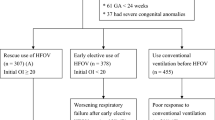Abstract
This randomized controlled study was conducted to compare the efficacy and safety of High frequency oscillatory ventilation (HFOV) and Synchronized intermittent mandatory ventilation (SIMV) in preterm neonates with hyaline membrane disease requiring ventilation. The ventilation strategy in both the groups included achieving optimal lung recruitment and targeted blood gases. 49 patients received HFOV and 61 SIMV. The baseline characteristics were similar in both the groups. HFOV group demonstrated better early oxygenation, enabled reduction in oxygenation index (OI) within 24 h of ventilation (difference in mean OI at 1, 6, & 24 h of ventilation: P=0.004 in HFOV, and 0.271 in SIMV group). Duration of hospital stay was shorter in HFOV group (P=0.003). The complication rate and survival were similar in two groups.
Similar content being viewed by others
References
Oxford Region Controlled Trial of Artificial Ventilation OCTAVE Study Group. Multicentre randomised controlled trial of high against low frequency positive pressure ventilation. Arch Dis Child. 1991;66:770–775.
The Acute Respiratory Distress Syndrome Network. Ventilation with lower tidal volumes as compared with traditional tidal volumes for acute lung injury and the acute respiratory distress syndrome. N Engl J Med. 2000;342:1301–1308.
Dreyfuss D, Saumon G. Ventilator-induced lung injury: lessons from experimental studies. Am J Respir Crit Care Med. 1998;157:294–323.
Yoder RA, Siler-Khodr T, Winter VT, Coalson JJ. High frequency oscillatory ventilation: effects on lung function, mechanics, and airway cytokines in the immature baboon model for neonatal chronic lung disease. Am J Respr Crit Care Med. 2000;162:1867–1876.
Hamilton PP, Onayerni A, Smith JA, Gillan JE, Cutz E, Froese AB, et al. Comparison of conventional and high frequency ventilation: oxygenation and lung physiology. J Appl Physiol. 1983;55:131–138.
deLemos RA, Coolson JJ, Meredith KS, Gerstmann DR, Null DM. A Comparison of ventilation strategies for the use of high frequency oscillatory ventilation in the treatment of hyaline membrane disease. Acta Anaesthesiol Scand. 1989;33:102–107.
Cools F, Henderson-Smart D J, Offringa M, Askie LM. Elective high frequency ventilation versus conventional ventilation for acute pulmonary dysfunction in preterm infants. Cochrane Database Syst Rev. 2009; 3: CD000104.
Thome UH, Carlo WA, Pohlandt F. Ventilation strategies and outcome in randomized trials of high frequency ventilation. Arch Dis Child Fetal Neonatal Ed. 2005; 90: F466–F473.
Diwakar KK, Bhaskaranand N. Early experience with high frequency ventilation in neonates. Indian Pediatr. 1999;36: 379–383.
Aggarwal R, Downe L. Use of high frequency ventilation as a rescue measure in premature babies with severe respiratory failure. Indian Pediatr. 2000;37:522–526.
Working Definitions. National Neonatal Perinatal Database of India, 2002–2003.
Random Integer Generator. Available from: http: //random.org/ integers. Accessed on June 21, 2007.
Northway WH, Rosan RC, Porter DY. Pulmonary disease following respiratory therapy of hyaline membrane disease; bronchopulmonary dysplasia. N Eng J Med. 1967;276:357–368.
Chapman IA, Stoll BJ. Nosocomial infections in the Nursery. In: Taeusch HW, Ballard RA, Gleason CA, editors. Avery’s Diseases of Newborn. 8th ed. Philadelphia: Saunders Publishers; 2005. p. 578–594.
Hulley SB, Cummings SR. Designing Clinical Research: An Epidemiologic Approach, Ist ed. Baltimore, USA: Lippincott Williams & Wilkins Publisher; 1988.
Courtney SE, Durand DJ, Asselin JM, Hudak ML, Aschner JL, Shoemaker CT, for the Neonatal Ventilation Study Group. High-frequency oscillatory ventilation versus conventional mechanical ventilation for very low birth weight infants. N Eng J Med. 2002;247:643–652.
Johnson AH, Peacock JL, Greenough A, Marlow N, Limb ES, Marston L, et al. High frequency oscillatory ventilation for the prevention of chronic lung disease of prematurity. N Eng J Med. 2002;347;633–642.
HiFO Study Group. Randomized study of high frequency oscillatory ventilation in infants with severe respiratory distress syndrome. J Pediatr. 1993;122:609–619.
Gerstmann DR, Minton SD, Stoddard RA, Meredith KS, Monaco F, Bertrand JM, et al. The Provo Multicenter early high frequency oscillatory ventilation trial; improved pulmonary and clinical outcome in respiratory distress syndrome. Pediatrics. 1996;98:1044–1057.
Author information
Authors and Affiliations
Corresponding author
Rights and permissions
About this article
Cite this article
Singh, S.N., Malik, G.K., Prashanth, G.P. et al. High frequency oscillatory ventilation versus synchronized intermittent mandatory ventilation in preterm neonates with hyaline membrane disease: A randomized controlled trial . Indian Pediatr 49, 405–408 (2012). https://doi.org/10.1007/s13312-012-0084-7
Received:
Revised:
Accepted:
Published:
Issue Date:
DOI: https://doi.org/10.1007/s13312-012-0084-7




